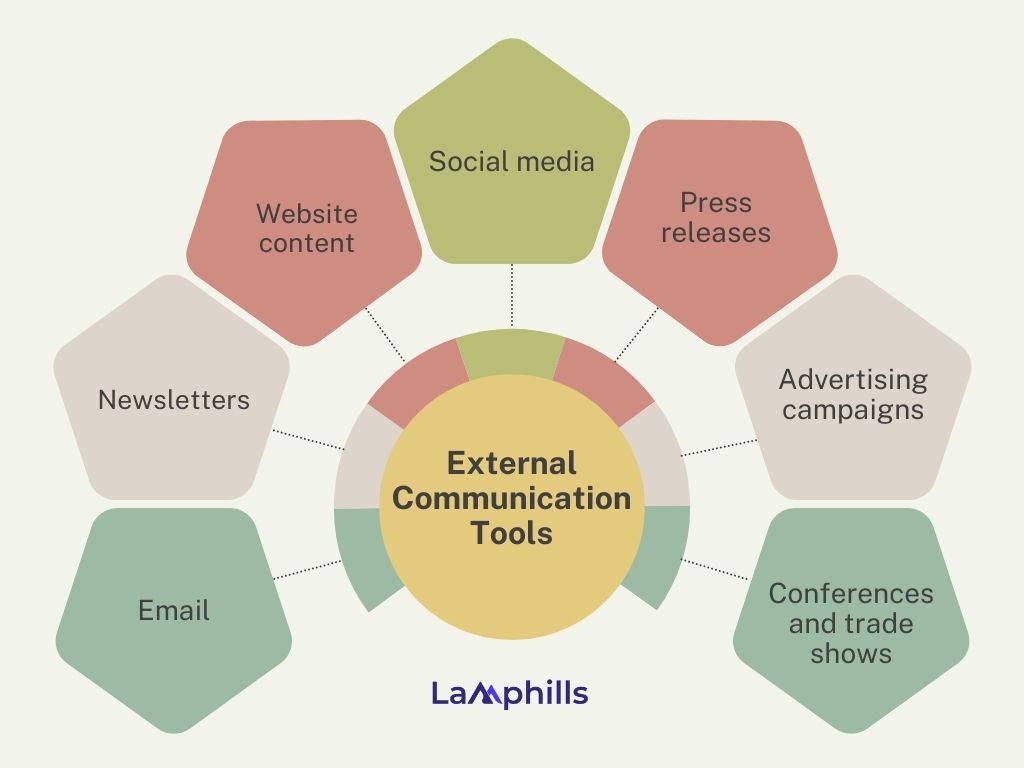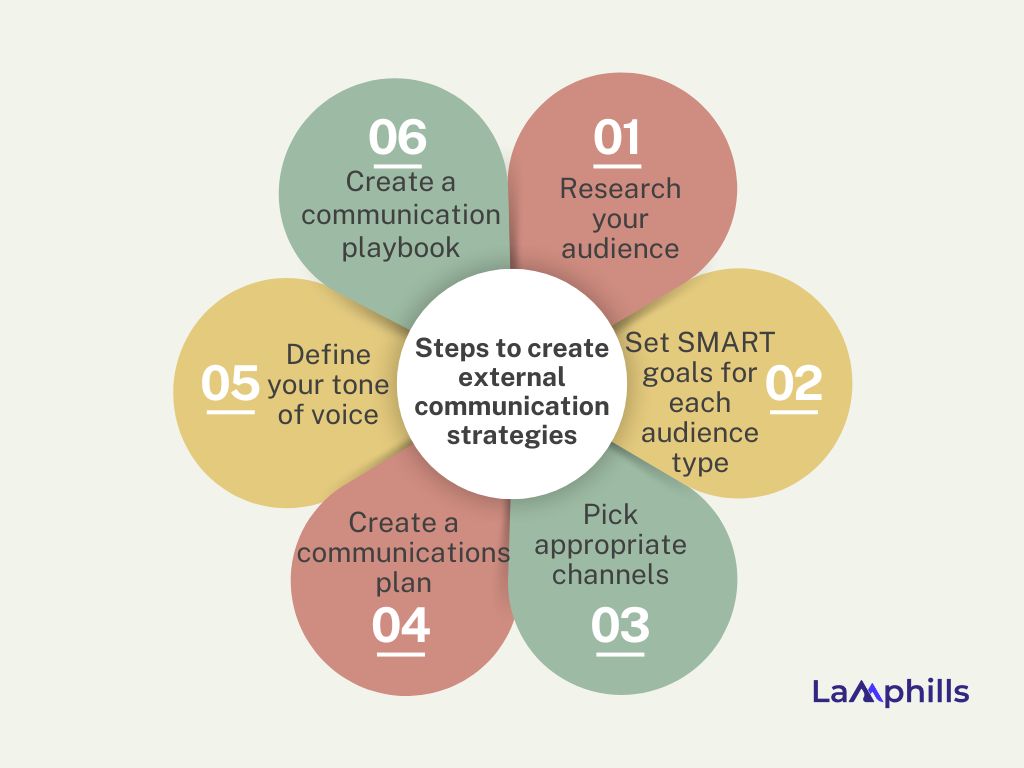External communication is exactly what it sounds like; communicating with external stakeholders. If I had a brand and, let’s say in the case of a crisis, I needed to communicate with the press or general public, I would have to utilize external communication tactics.
External communication is an essential part of any business and forms a crucial part of any company’s business plan or marketing strategy. The focus of external communications is simple: to build a thriving relationship between your organization and your customers, other companies, your suppliers, and other entities in the value chain distribution.
Key Points
- External communication refers to exchanging information between a company and external entities.
- These include customers, suppliers, investors, media, and the general public.
- External communication can be classified into numerous categories, including advertising, public relations and customer service.
- Internal communications, in contrast, are exchanges of information that occur inside an organization between staff or other internal audiences.
- Effective external communication goes a long way in defining the success rate of any business.
Understanding External Communications
External communication refers to exchanging information between a company and external entities such as customers, suppliers, investors, media, and the general public. It involves conveying messages and information about the company, its products or services, and its values to the outside world.
External communication is an important part of any business because it helps the business to engage with its customers and reach new audiences. With external communication, you can:
- Maintain good relationships with existing customers: External communication helps retain existing customers. It can help to update customers on new products and build brand loyalty and affinity.
- Share news and developments about the business: It’s important to inform partners, shareholders and important clients of any changes to the business or news that may affect their relationship with the business.
- Build brand identity: The way a company communicates, the words it chooses to use and even the images it chooses to share all help to build and reinforce a chosen brand identity. This can help create an affinity between the business and its customers and attract new audiences.
- Improve brand awareness: External communications, including advertising campaigns and website and social media content, can all improve brand awareness and ensure the public knows about a business.
- Communicate with suppliers: Maintaining a strong working relationship with suppliers is crucial to the success of any business. Strong external communications with suppliers can help to build lasting business relationships that benefit both parties.
External communication promotes the company’s image, enhances its reputation, and builds relationships with its stakeholders. It is also used to inform and educate the public about the company’s products or services, new developments, and changes in policies or procedures. It aims to create a positive image of the company in the minds of its stakeholders and the general public.
Types of External Communication
External communication can be categorized into the following types:
- Advertising: communicating the benefits and features of a product or service to potential customers through various channels such as television, online media, radio, and print.
- Public relations: This involves managing the image and reputation of the organization through communication with various stakeholders, such as customers, investors, and the media.
- Customer service: This involves responding to customer inquiries and complaints.
- Personal selling: This involves face-to-face communication between the organization’s representative and the customer to persuade them to buy the product or service.
- Corporate communication: This involves communicating with various stakeholders about the organization’s mission, values, and goals, as well as providing updates on company performance and initiatives.
External Communication Tools
There are several tools a business can use for external communication with customers, clients, shareholders, investors or anyone else that the business may want to communicate with. Each tool has a valuable role to play in the marketing mix of a business and contributes to the overall marketing strategy to help the business grow.

Many employees communicate externally via email. It is the most basic and regular type of external communication.
While businesses tend to use it as an informal means of communication, it’s usually good practice for a company to have an email policy and some guidelines that they encourage staff to follow in their email communications.
Email guidelines might include a list of recommended salutations and professional email sign-offs. They could also include lists of words to use or avoid and a template for email signatures that includes all the relevant company information. Email is a vital communications tool for almost any business and it mustn’t be overlooked or undervalued.
Newsletters
While businesses may not often use printed newsletters anymore, email newsletters, or ‘e-news’, are popular and effective external communications tools. Email newsletters can help build a customer database by encouraging people to sign up for updates from the company. Through the analysis of engagement metrics,
While businesses may not often use printed newsletters anymore, email newsletters, or ‘e-news’, are popular and effective external communications tools. Email newsletters can help build a customer database by encouraging people to sign up for updates from the company. Through the analysis of engagement metrics, they can help identify the most engaged customers.
Email newsletters provide businesses with an opportunity to communicate with customers in a more lengthy and in-depth way than traditional advertising. Because they have signed up for it, recipients are more likely to read and respond to any communications put out via a newsletter. It’s valuable to have a template and a schedule for email newsletters to ensure consistency and that the business sends them out regularly, but not too frequently.
Website Content
A company’s website is where it can communicate essential information about the business to the public. The business may even sell its products via its website, making it an even more critical element of the sales and marketing process.
Even for companies that don’t use their website for sales, a clear, concise, and engaging website is a valuable communication tool. A company uses its website to project its desired brand image, identity, and values, while at the same time communicating critical information that can help people and organizations decide if they want to do business with it.
There are many tools and techniques for ensuring a website is as visible as possible and communicates with its customers in the best possible way. These include the use of engaging and relevant imagery and content marketing techniques, such as blogging.
Social Media
Social media offers businesses an unprecedented level of access to and communication with their customers. It has become one of the most valuable external communication tools. It helps businesses to advertise their products, but also to build their brand identity and engage in discussions with customers and potential new audiences.
Social media marketing has become a central part of the marketing mix for both large and small companies, and businesses use it according to their size, scope and strategy. Content on the company’s social media channels can help drive traffic to the company website or reinforce its brand identity. The use of brand ambassadors and influencers has also become a valuable tool in promoting products and services and reaching new audiences.
Press Releases
Press releases are a traditional form of external communication and one that can be very effective. They’re used for communicating news to a wider audience, including information about new products or a change to the business.
A press officer prepares and sends press releases from the company to a list of local or national press and media contacts. Part of the press officer’s job is to grow and improve this list of media contacts to help place press releases in the best media channels to reach the desired audience.
You might also like to read: How To Send a Press Release: Your Personal Guide to Making Waves in the Media
Advertising Campaigns
Advertising campaigns tend to be the most visible type of external communication with customers. This can take many forms, but each has a clear strategy to engage the customer, reach new audiences, and increase sales of a product or service.
Companies use advertising campaigns to communicate directly with their audience. Advertisers design campaigns so that every word, sound, or image has the greatest impact on its audience and establishes or reinforces a company’s brand identity. Advertising is the most effective external communication tool for reaching a mass audience.
Conferences and Trade Shows
Some businesses use conferences to build relationships with their partners and customers. Companies can use conferences to communicate important information about the company, establish new networks, maintain relationships, or increase sales. Some companies run their own conferences, while others may exhibit at conferences or attend them for the purpose of networking.
Read 5 Keys to Building Business Relationships
Trade shows can also be a useful tool for businesses to reach new audiences and network with potential customers, suppliers, or partners.
Steps To Create External Communication Strategies

Research Your Audience
First, list the types of external audiences you’re targeting, from customers to investors. Then, research each audience type by reading studies, sending surveys to your contacts, or holding one-on-one interviews.
Document your findings into categories including:
- Demographics such as age and location
- Firmographics such as company and job title
- Pain points such as cost optimization
- Buying or investing behaviors such as product preferences
Finally, use the insights to group your audience into multiple segments—they’ll help you personalize communications later on. For instance, segment an investor audience into firmographic categories like venture capital firms and angel investors.
Set SMART Goals For Each Audience Type
Goals guide your external comms decisions while acting as benchmarks for results. Let your audience research and business needs inform your goals. For example, launching new products could prompt customer conversion goals, whereas ambitious growth plans could spur investor funding goals.
Use the SMART framework to set goals that are:
- Specific: Target your objectives with precision, such as “Boost engagement among [target demographic]” instead of a vague “Engage more customers.”
- Measurable: Quantify your goals to track progress effectively, like aiming for a “25% increase in website traffic” rather than simply wishing for “more website visits.”
- Achievable: Set objectives within reach, like “Reduce operational costs by 5%” instead of an overly ambitious “Slash all expenses in half.”
- Relevant: Tailor your goals to align with your organization’s core mission. For a tech company, enhancing software efficiency is more aligned than branching out into unrelated retail ventures.
- Timely: Assign a clear deadline to your ambitions, such as “Launch the new product line by Q3” rather than an indefinite “Launch the new product line eventually.”
Pick Appropriate Channels
Research which channels your target audiences use and ensure they provide the tools you need to add value—such as information or offers—to your audience.
Generally speaking, here’s what key channels are useful for.
- Email: Build relationships with, convert, and negotiate with warm contacts such as current and potential customers, investors, and suppliers.
- Social media: Increase product awareness, share company news, and create interactive content showcasing your brand values.
- Blog and white papers: Build trust, increase web traffic, and generate new customer leads.
- Business messaging app: Resolve everyday problems securely with clients and suppliers.
- Video calls and webinars: Collaborate, train, and bond with customers and the public in real-time.
Define Your Tone of Voice
If your brand were a person, how they sound to others is their tone of voice. So, define that tone for each audience type. For instance, your customer-facing tone could be friendly and informal, while the regulator-facing one is formal and precise.
However, all your tone choices must match your brand’s mission and values. For example, values like excellence and innovation go well with a confident, inspiring tone of voice.
Here’s a quick way to define your tone of voice for a customer audience.
- Target audience: Busy senior managers in [industry]. They need precise and quick information about [specific product]. They’re cost-conscious but prioritize quality.
- The tone of voice: Our communications are informative and concise. We address customer pain points with empathy and confidently emphasize our unique value proposition.
You can expand on this example to create a 1-2 page definition document for your comms team.
Create a Communication Playbook
A communication playbook is the go-to manual for employees running your external comms. It should outline the goals, channels, and tone of voice for each external audience. Then it should provide guidance and examples for communications:
- Timing: Specify the frequency, dates, and times for communications on different channels.
- Editorial guidelines: Confirm grammar, spelling, punctuation, and other styling decisions.
- Best practice: List tips and techniques such as phrase repetition, the rule of three, and first-person stories.
- Content and topics: Confirm key messages that engage audiences and support internal goals.
Create a Communications Plan
A communication plan includes campaign phases, tasks, stakeholders, deadlines, and key messages. Create one for each audience type and campaign. For instance, a product launch campaign could have a threefold plan engaging customers, investors, and the public.
Use project management software to share your plan with key stakeholders, track task progress, and enable collaboration. Remember to update your plan based on audience insights or feedback.
How to improve external communication
Benefits of External Communication
Effective external communication goes a long way in defining the success rate of any business. A solid external communication game makes customers feel more connected and emotionally attached to brands.
A simple monthly newsletter about an upgrade to a product or service keeps the customer in the loop with an assurance of security dealing with the brand. As an aside, it is also a great way to boost employee experience when employees receive timely updates about happenings in the company.
Here are some other advantages of external communication:
- Developing community relations. External communication helps businesses build community relationships. By sharing information and updates about the company’s activities, businesses can create a positive image and build trust with the community.
- Communicating and leveraging information. External communication helps businesses share information about their products or services and their benefits which can be used as leverage to attract new customers, retain current ones, and gain a competitive advantage in the market.
- Building brand identity. External communication is critical to building a brand identity. A consistent message across all external communication channels helps to create a strong brand identity and increase brand awareness.
- Optimizing external networks. External communication helps businesses optimize their external networks by building relationships with suppliers, investors, and partners.
- Relations with suppliers. External communication helps businesses to maintain good relations with their suppliers. By sharing information about their plans and requirements, companies can ensure a steady supply of goods and services.
Best Practices For Effective External Communication
At this stage, you’re probably wondering what measures you can take to enhance your external communications so that it helps generate the interest and attention you need and create powerful and positive relationships for your organization’s long-term survival.
I’ve got you; here are six best practices you can apply to make the most of your external communication strategy:
Know Your Audience
Even the best communication tricks, marketing hacks, and network strategies will be a waste if they don’t resonate with your audience. For your messages to be effective, you need to talk in your audience’s language, so you need to have an in-depth understanding of your different stakeholder segments.
Here’s a quick rundown:
- Investors and shareholders: People outside of your organization that provide the necessary funds and resources to keep your business growing.
- Influencers and partners: Individuals you might want to work with in the future to develop your brand.
- Prospects and customers: People who buy your products or services, boosting sales and generating revenue.
- Government and law enforcement agencies: Groups regulating your industry, ensuring your organization is in compliance with applicable standards and regulations.
As each group has its own motivations for your brand, create a unique buyer persona for each group to get the focus you need to better connect with the right people and generate positive responses.
Build Your Tone Of Voice
An external communication strategy helps shape the public narrative and how audiences connect with your organization. And a key element of building one is knowing your brand’s tone of voice.
Think about how you want your audience to remember, engage, and talk about your brand. This will give your external communications a tone and personality that people can associate with your company. The idea is to deliver quality communications while sounding genuine.
Avoid emulating industry trends as much as possible so your style and voice stand out. Let’s not forget general communication can be boring. If you want to get audiences excited, you need to think of creative and innovative ways to be unique.
Choose The Right Platforms
Identify the platforms where your target audience spends their time and where you can communicate most effectively with them. For example, you can leverage social media to reach a large number of your customers, but if you want to work with an industry publication to connect with partners and investors, you’ll need to send emails and issue press releases.
You have plenty of options to get your messages across, including television, radio, and in-person events, but focus on choosing the right platform that gives volume to your message and improves ROI.
Prioritize Delivering Value
Don’t be like those brands that make a lot of noise without actually delivering anything of value.
For example, instead of emphasizing how amazing your product or services are, mention information your targeted audience segment will actually care about. Let’s say you’re reaching out to investors for funding, think about what they would like to know — perhaps, you can mention your average annual profit or how you deliver ROI.
This will help you make a solid connection and ensure your message resonates with the audience.
Get a Process Documentation Tool
When building your organization’s external communication plan, you must also take measures to document and share processes and procedures clearly and in straightforward language. This will eliminate any confusion and ensure team members are in the loop on what needs to be done and how.
External Communication vs Internal Communication
External communications are any communications between the company and external entities. Internal communications, in contrast, are exchanges of information that occur inside an organization between staff or other internal audiences, such as contractors working in the business. Internal communication can include emails, the use of an intranet or project management tools, phone contact, and written documents or literature staff receive.
Companies can use internal communication to increase a sense of belonging and identity among staff or to clarify the vision, mission, and values of the company. Managers or human resources can also use it to communicate practical information to employees.
There are clear strategic differences between internal and external communications. While businesses use internal communications to improve staff relations and create a positive work environment, external communications are typically related to increasing sales and growing the business.
Both internal and external communications are useful tools for a business. They fulfill different functions for the business but both types of communication services improve the image of the company and help the business grow.
Other Types Of Communication
There are several types of communication, all of which are used in business daily. These are:
- Internal communication happens among employees of the same business.
- External communication happens between employees of a company and external entities (employees of another business, customers, external stakeholders, etc.).
- Vertical communications: in hierarchical businesses, if a message is communicated from a higher level to a lower level or vice versa, this is called vertical communication.
- Horizontal communication is communication between the same levels of a hierarchy.
- Formal communication refers to the official messages and statements sent by an organization.
- Informal communication is the casual conversation that happens between colleagues or an unofficial conversation for which the organization is not liable.
Another aspect of communication is one-way and two-way communication. In two-way communication, the receiver can respond to the message from the sender, while in one-way communication, the receiver cannot reply.
It’s important to note that these types of communication are not mutually exclusive and often overlap with one another. For example, formal communication can be both vertical and internal, as it involves structured communication between different levels of the organization.
Recommended Articles
- Best Steps To Effective PR Crisis Management
- How To Send a Press Release: Your Personal Guide to Making Waves in the Media
- Corporate Communications: Strategies to Amplify Your Brand’s Message
- How To End a Conversation Politely & Professionally: Detailed Tips






